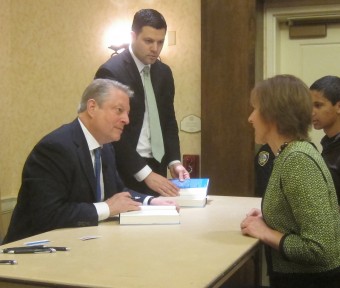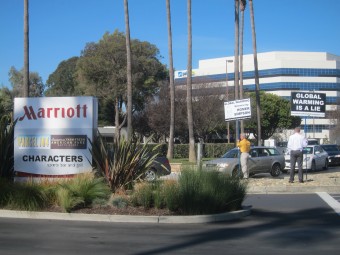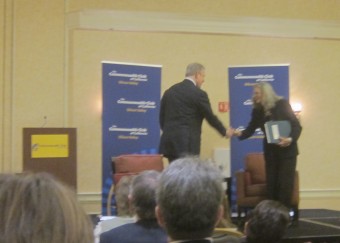By Alison van Diggelen, host of Fresh Dialogues
Yesterday, Al Gore braved the picket line in Silicon Valley to appear at the Commonwealth Club and discuss his new book, “The Future: Six Drivers of Global Change.”
Needless to say, Fresh Dialogues was keen to turn the conversation from issues of World Brain and Thomas Paine to Gore’s forte: climate change. Fortunately for the climate-concerned, the talented moderator, CwC Club CEO Gloria Duffy chose our burning question from the dozens of wannabees that landed on her lap.
Gore is forceful in his call for a carbon tax and optimistic in his description of the growing investment in, and the reducing price of renewable energy. He also explains why Silicon Valley will retain its preeminence in technology innovation, particularly in cleantech, despite future challenges.
 Fresh Dialogues: What can President Obama realistically hope to achieve in his second term to combat climate change?
Fresh Dialogues: What can President Obama realistically hope to achieve in his second term to combat climate change?
Al Gore: I’m hoping that tonight, just a few hours from now (during the State of the Union address), that he will announce that he’s going to have the EPA regulate for global warming pollution for existing existing power plants and facilities. It’s already been applied to newly constructed facilities, and being challenged in court; but there was a ruling in 2007 that global warming pollution is included under the Clean Air Act. So I’m hoping that he will do that as a minimum. But ultimately we’re going to have to put a price on carbon, either directly with a CO2 tax or indirectly with a a carbon cap and trade system, by whatever name.
Many other countries are now moving closer toward that. China has implemented a pilot program in two cities and five provinces; and has announced it has a pilot for a nationwide cap and trade system. India has put a tax on coal. Australia, the largest coal exporter in the world has implemented both, a CO2 tax and cap and trade. Seventeen other countries are moving rather quickly in this direction, South Korea, Ireland among them. European Union is already there. As of January 1, California has been the leader, once again…Quebec, British Columbia. Local and regional governments around the world. It’s not enough yet, and we do need a nationwide system. And for those who say, ‘it might make us less competitive,’ first I strongly disagree; but the World Trade Organization rules allow for border adjustments if some country doesn’t include its carbon pollution in its export prices, so it doesn’t affect competitiveness, except in a positive way, because we have invented most of these technologies, we aught to have the jobs created here.
Yesterday it was announced that the number one new source of electricity generation in the US in 2012 was from wind energy. Australia announced last week that electricity from wind is  now cheaper than electricity from new plants run by either coal or natural gas. The price of renewables is coming down continually, the more we use, the cheaper it gets. It’s one of those virtuous circles, and cost down curves like Moore’s Law. It’s not quite that steep but it’s extremely impressive.
now cheaper than electricity from new plants run by either coal or natural gas. The price of renewables is coming down continually, the more we use, the cheaper it gets. It’s one of those virtuous circles, and cost down curves like Moore’s Law. It’s not quite that steep but it’s extremely impressive.
In 2010, for the first year in world history global aggregate investments in renewable energy exceeded global aggregate investments in fossil fuel….these are trends that are extremely powerful and I hope that the administration here does find a way to put a price on carbon. The idea that it’s a so-called externality that we can safely ignore is ludicrous. It’s just ludicrous.
Can Silicon Valley keep the crown as No. 1 tech innovation hub? 
Having spent over two years researching future trends with futurist experts such as Ray Kurzweil, Gore remains bullish about Silicon Valley’s future as the innovation and tech capital of the world. He acknowledges that the Internet is a force for creative destruction that redistributes expertise, opportunities, and capital, but concludes that a need for innovation hubs will remain, attracting people with the best science, industry and technology skills.
“Silicon Valley is going to remain the epicenter of high technology development,” he says. “Principally in the digital technologies but increasingly in green technologies. Even though it’s been a roller coaster ride, the momentum of green technology around the world is incredible.”
He likens Silicon Valley’s expertise in tech to Milan’s in fashion, pointing out that despite our ability to get fashion trends online, Milan remains a center of fashion in the world, because the best minds in fashion go there. He adds, “The importance of people being able to meet and collaborate in person ensures the continued importance of particular geographic centers of expertise.”
Update on SOTU
Obviously, Al Gore was wrong in assuming that President Obama would announce an extension of EPA regulations to existing power plants in his SOTU; however, I have no doubt he’s delighted at the president’s call to action:
“For the sake of our children and our future, we must do more to combat climate change!”
President Obama also urged congress to pursue a bipartisan market-based solution to climate change and announced his plan to use his executive powers to speed up the transition to more sustainable energy sources and use some oil and gas revenues to create an energy security trust to drive new research and technology to shift cars and trucks off oil “for good.” Does that mean more federal funding for electric vehicles?
He added: “So tonight, I challenge you to join me in setting a new goal: By 2035, 80 percent of America’s electricity will come from clean energy sources.”
Check back soon for more details.




